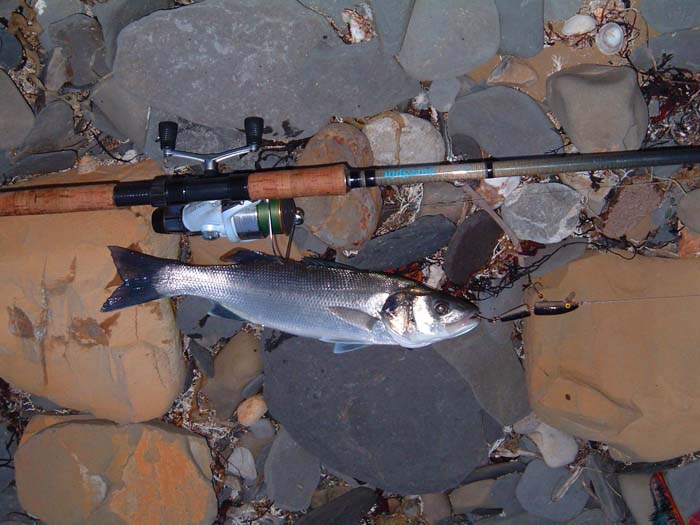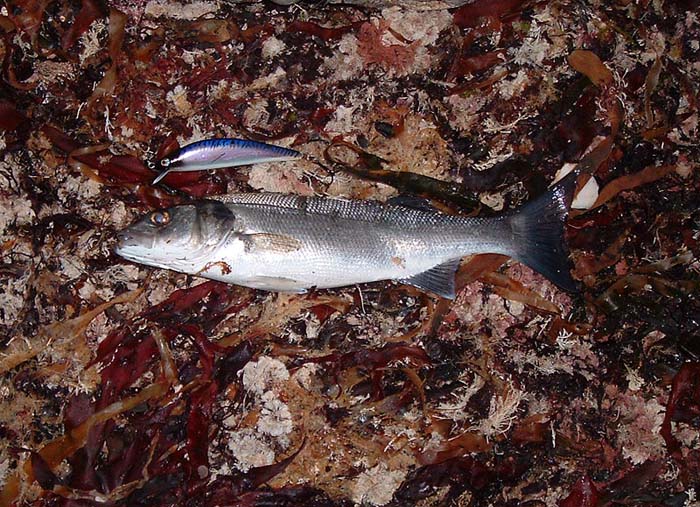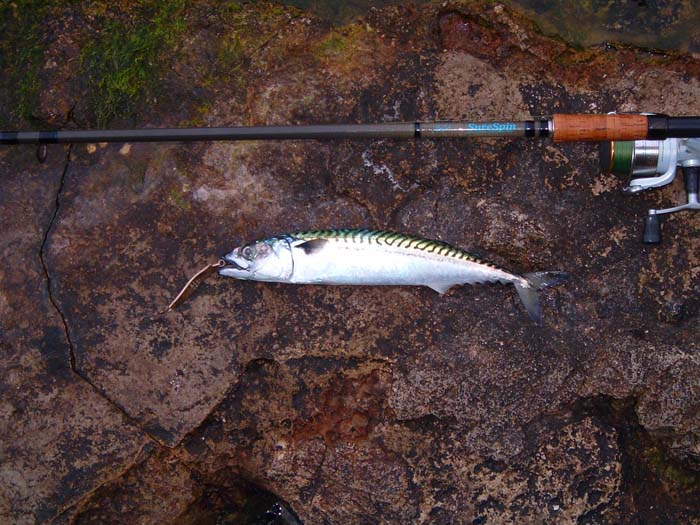 '
'Information Page.
Windy weather.
A beginner’s guide to spinning for bass
A long time ago, following a trip to a B.A.S.S. AGM, I wrote a guide to the basics of bass spinning. I still get asked the same questions so I thought it might be interesting to revisit what I said and see how things have changed. I've highlighted my new comments in lime green so you can easily see what's changed.
Why spin?
Bass eat a lot of fish, squid, prawns and other active animals. The best way to deceive a fish is (still) certainly to present a natural, live-bait on simple tackle. However, natural bait is not always easy (or cheap) to come by, so an effective artificial can be a life saver.
On those rare occasions when the bass are “mad on” or passing through at speed it is MUCH quicker to use an artificial (no fiddling about with bait needed). If the fish are scattered over miles of shoreline, it is easier to search for them by casting and retrieving a lure as you move along. Thirdly, and perhaps surprisingly, some types of imitation fish are less prone to snagging than most bait rigs.
Where and when to spin!
Essentially ANYWHERE that you think there could be bass; over sand, gravel, rock, weed or in open water; from the very MARGIN of the sea to offshore reefs, wrecks and shoals; at ANY state of tide. Obviously success will depend on whether there are any bass present (you may be surprised – I often am!). At any time of the year -although APRIL to NOVEMBER (inclusive) is the prime period. From my local shores big fish are most often taken at the extreme beginning and end of the season and big catches often in May and June.
As a general (but not hard and fast) rule, in Dorset, I fish rocky beaches, ledges and headlands on the spring tides and gravel beaches and bays on the neaps. Any conditions from flat calm/gin clear to force eight/white water will be O.K. Even quite dirty water is not a total dead loss.
Tackle to use!
A medium sized fixed spool reel is, by far, the most versatile. The cheapest models are rarely ideal but anything with a smooth clutch and reasonable level wind will be O.K. I am not the man to ask about makes and models of tackle - as long as it works I use it. If you want you can give the reel a wash after every trip - I never bother but my gear is NEVER put away in a bag, box or car boot. Made up rods and reels are propped in the corner of the room where I am writing this (now in my little rod cupboard) and even non-saltwater proof reels last a few years under these conditions (although they don’t always look ‘nice’ after a few soakings in the drink).
Load the spool of your spinning reel almost to the brim with line. I use 8lb Maxima, T Line or similar monofilament (No longer - I now use 20-30lb Whiplash or Dynon 3000 braid). Don’t overfill or you will have to cut a few yards off when it tangles on the cast (this still applies). If you are new to spinning, want to use only big lures or think that your beaches are snaggier than mine (want a bet!) step up to ten pound nylon (no need if you use braid of course). You can go down to five or six if you think it is more 'sporting' but, believe me, you will one day (probably quite soon) regret it.
My favourite rod(s) are 11 ft, 1.75 lb test curve, carp-type, through action blanks (these days I use custom made spinning rods which are slightly more powerful). Any spinning rod of your choice will do but remember it must be sufficiently forgiving for (knotted) 8 lb line (no problem with the braids) and powerful enough to set the hooks against the tough mouth of a bass and the drag of a bulky lure (easy with non-stretch braid). I feel that the longer rod gives me good lure/fish control amid waves, weeds and boulders.
Now all you need are a few lures. First let me say that these are not cheap but compared to the cost of bait (I used to buy 12 worms per week for mullet and bait fishing and it cost me about £50 per year even then) it should be no problem. Lures last for ages if you don’t lose them. I generally tie the smallest link swivel I can find to the end of my line, using a half-blood knot (now I use a non-slip loop knot and no link). CHECK EVERY KNOT! Clip the lure on, SHARPEN THE HOOKS! and away you go. If you want to change the hooks use good quality trebles, not too thick in the wire (the idea is to sink them easily into a fish not to anchor the QE2).
What lures should you have in your box?
I “like” to carry two or three of each basic type but rarely is that the case (two should be plenty). A good selection might be -
A couple of medium sized silver Tobys (or something similar ABU Tormentor, Dexter Wedge, etc.) for those RARE occasions when I want to belt them to the horizon or catch a mackerel for bait.
Big silvery Redgills (or similar) for fishing THROUGH weeds (nowadays self weighted shads are probably better)
Black/silver or blue/silver J13 (fishes deeper), J11, J9, J7 and 5cm floating Rapalas.
Greenish/bronze/silvery Rebel J30, J20 and J10 Floaters for getting down a little deeper than the Rapalas. Orange/brown Rebel Crawfish in the smallest and medium sizes (for wrasse). (All these could be replaced by a couple of Angel Kiss or Chase plugs)
A couple of home made mullet spinners (for mullet and smaller bass).
A total of 24 lures at (say) an average of five pounds (now £10) each. Total £120 (£240)
If you are happy with one of each then £60 (£120). If you skip a few sizes (I usually do) perhaps £40 (£80) worth of lures, and say £20 (£40) for annual replacements. Of course I realise that if you are new to bass spinning or covering new ground then you could lose two or three plugs on your first session but my average loss rate is (still) about one or two per season (usually in snags not in fish). If you are hard up then you could settle for just a couple of J11’s (Maria Chase) and not go far wrong. Or you could make your own from balsa at a fraction of the price (glue on a strip of metal foil and give them a few coats of varnish). DIY plugs have the advantage that you can customise the weight, shape, colour and depth of dive to your needs. (This is still an option for the DIY angler).
There are many other good makes of buoyant plug bait. I like the Nils Masster Invincible and various Bombers. Most reputable types are O.K. but there really is no need to carry a suitcase full of plastic and balsa. If your personal coastline is steep and deep it may be worth experimenting with some deeper divers. (Nowadays a couple of surface poppers are almost essential – they cast a long, long way and are difficult to lose even on the snaggiest, shallowest ground. To be honest I’d say forget most of the above because two plugs and two poppers – perhaps forty quid’s worth - would suffice for 95% of your fishing).
Just one or two more thoughts. Don’t be afraid to fish - In shallow water (1’-2’ deep), over rock and weed, in rough weather, CLOSE IN (stand back up the beach and flick the lure a couple of yards out at times), in clear water, in fast tides. Reel in just fast enough to make the lure work (say one turn of the handle per second) THIS WILL CATCH BASS, then when you gain confidence you can improvise with fast/slow or fancy retrieves. Keep your eyes peeled for signs of fish activity (splashes, flashes, swirls, tails, fins, shapes and shadows, explosions of little fish, diving - terns, gulls, guillemots, razorbills etc.). All of this still applies – the tackle might have changed but the habits of bass haven’t.
If you have any comments or questions about fish, methods, tactics or 'what have you.'get in touch with me by sending an E-MAIL to - docladle@hotmail.com
J11.
 '
'Maria Chase.
 '
'Toby.
 '
'Surface popper.
 '
'